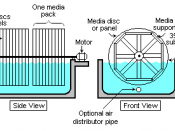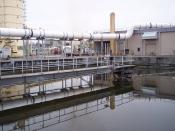Vineet Baldwa 10C
Role of sewage treatment in controlling water pollution
Introduction
In today's world, the four basic necessities of any person is a house, clothes, food and water. Water is the basis of all life. Water is needed for many purposes like drinking, cooking, bathing, cleaning and recreation. On the earth, there is an abundance of water. About 75% of the earth is covered with water. However out of all this water, 97.2% is found in the oceans as saltwater and is therefore useless. Out of the remaining 2.8% of freshwater, about 90% is found as ice in the polar ice caps and cannot be used. Therefore only a very small percentage of water can be used. Since water is a scarce resource, it has to be re-used again and again. Most used water is removed from homes, offices and factories as sewage. Because of the scarcity of water, the sewage needs to be cleaned (treated) so that it can be re-used.
If not, the dirty water causes water pollution.
Sewage
Sewage is the liquid waste produced by humans which typically contains washing water, faeces, urine, laundry waste and other liquid or semi-liquid wastes from households and industry. It is one type of wastewater. Sewage collection and disposal is usually done via a system of sewer pipes (sewers) called sewerage, and sometimes via a cesspool emptier.
Water Pollution
Water pollution is a large set of adverse effects upon water bodies (lakes, rivers, oceans, groundwater) caused by human activities. Water pollution has many causes and characteristics. Organic wastes such as sewage and farm waste impose high oxygen demands on the receiving water leading to oxygen depletion with potentially severe impacts on the whole eco-system. Industries discharge a variety of pollutants in their wastewater including heavy metals, organic toxins, oils, nutrients,


